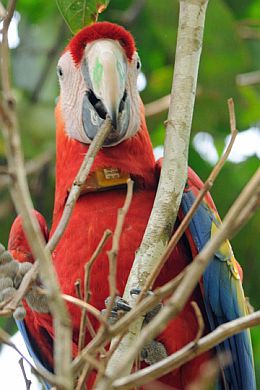Palenque, Chiapas, Mexico - A flock of scarlet macaws has been released in southern Mexico as part of a reintroduction project to return this charismatic bird to its former range. The macaws were released into the jungles of Aluxes Ecopark, near Palenque National Park in Chiapas, and all 17 individuals so far appear to be doing well. The project comes after years of coordinated efforts between Aluxes Ecopark, Xcaret Ecopark, the Institute of Biology of the University of Mexico (UNAM), and the Mexican environment agency (SEMARNAT).
Macaws Under Threat
The scarlet macaw is widespread across Central and South America, and is currently classified as Least Concern on the IUCN Red List. However, this vibrantly colored species has all but disappeared from southern Mexico, mainly due to the destruction of its rain forest habitat and over-collection for the pet trade.
Fortunately for the macaw, forest restoration projects, awareness campaigns, and protection of Palenque National Park have significantly reduced tropical rain forest destruction in the region, and the wildlife trade has also declined. Sufficient protection for the scarlet macaw and its habitat means that reintroduction is now a viable option to restore this species to its former range.
 |
A released-bird with transmitter. (Photo by Elise Voltura) |
Macaw Reintroductions
Before the scarlet macaw reintroduction project could go ahead, approval had to first be gained from the relevant authorities. The health and genetics of the captive-bred birds also had to be assessed to ensure that they were suitable for release.
The first macaw reintroduction took place in April, and a second small flock was released at the end of June. After this, small groups of 10 to 12 birds at a time will be released until a quota of 60 to 70 for this year [2013] is met. The reintroductions will then continue until 2015, and if successful will result in a doubling of the species’ current numbers in the region.
Speaking about the reintroduction, Alejandro Estrada, one of the leading researchers from the Institute of Biology at UNAM, explained that they should “create a scarlet macaw corridor that will reconnect the remnant populations with the introduced macaws and will result in a region-wide restoration of the scarlet macaw in its northernmost distribution in the Neotropics.”
Preparing for Release
Before the captive-bred scarlet macaws can successfully be released, they need to be trained in how to survive in the wild. This includes housing the birds in groups for several weeks to encourage them to form flocks, as well as training them to recognize wild foods and to avoid predators, including humans.
Once released, the birds will be provided with extra food to supplement their diets as they adjust to foraging for wild foods, which include fruits, nuts, seeds, flowers and leaves. According to Estrada, now that the first birds are living wild, they will be able to act as ‘tutors’ for new flocks, helping them to adapt more quickly.
The released macaws will be tracked over the coming years, to monitor how the reintroduction efforts are going. Artificial nest boxes will also be set up in the release area.
Encouraging Support
The macaw reintroduction efforts have received encouraging support from the Mexican government, which has helped to publicize the species’ return to the wild. Various campaigns have helped to build a sense of local pride in this beautifully colored bird, and the community around Palenque already appears to be captivated by its reappearance.
Those involved in the project are hopeful that this sense of pride in and concern for the scarlet macaw will also help to develop a greater interest in the conservation of the region’s tropical forests and the other species which inhabit them.
Read more at Mongabay.com.

